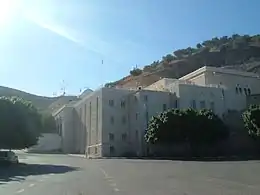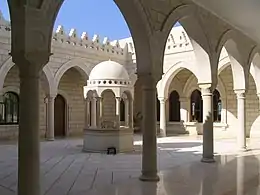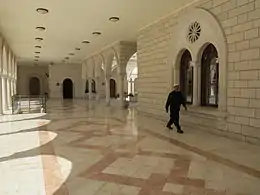Nabi Shu'ayb
Nabi Shuʿayb (also transliterated Neby Shoaib or Nabi Shuaib, meaning "the Prophet Shuʿayb") is a Druze religious prophet, traditionally identified with the biblical Jethro,[1][2][3] whose possible shrine/tomb is believed to be located near Kfar Zeitim, not far from Tiberias, Israel. The identification of Shuʿayb with Jethro, however, is a Druze tradition rather than historical fact (see Shuaib). Prophet Shuʿayb is the 14th prophet.

Nabi Shuayb was an object of traditional veneration by Druze through Palestine. The shrine figured down to Israeli-Arab war of 1948 as a place where Druze took vows (nidhr) and made ziyarat ("pilgrimages"). After the 1948 war, Israel placed the Maqam (shrine) under exclusive Druze care.[4] A central figure in the Druze religion, the tomb of Nabi Shuaib, has been a site of annual pilgrimage for the Druze for centuries.[5] Shrines dedicated to Nabi Shuaib are common throughout the Greater Syria region.[6]
History


In Druze tradition, it is believed that towards the end of his life, Shuʿayb took refuge in a cave outside Hittin (a village just west of Tiberias), where he would die in old age. His followers buried him at the site and placed a tombstone at his grave.[5] Another Druze tradition holds that the Ayyubid sultan Saladin had a dream the night prior to the Battle of Hittin in which an angel promised him victory on the condition that after the battle, he would ride his horse westward; then, where the horse would stop, the angel said he would find the burial site of Shuʿayb. The tradition holds that when Saladin's dream was realized, the Druze built a shrine for Shuʿayb at the site.
Nabi Shuʿayb has been expanded and renovated over time.[5] The older section of the existing structure was built in the 1880s, under the direction of Sheikh Muhanna Tarif, the shaykh al-aql (Druze spiritual leader) of Julis.[7] Sheikh Muhanna summoned an assembly of religious leaders in the community to discuss and collaborate on its construction. A delegation of high-ranking community members traveled to Syria and Lebanon in order to collect funds for new construction and renovations and the local Druze of the Galilee and Mount Carmel also made considerable contributions.
After Israel's establishment in 1948, and the total depopulation of Hittin which had been a predominantly Muslim village, the Druze were granted full custodianship over the tomb, and an additional 100 dunams surrounding it. Under the leadership of Sheikh Amin Tarif, the shrine was then renovated and numerous rooms were added for the hosting of pilgrims. The Israeli government also paved the road leading to Nabi Shuʿayb and provided electricity and water infrastructure services there.[5]
Pilgrimage
| Part of a series on
Druze |
|---|
 |
|

The first mention of the tomb dates back to the 12th century CE, and the Druze have held religious festivals there for centuries. According to Druze tradition, the imprint of Shuaib's left foot (da'sa) can be seen on the grave. Pilgrims visiting the site pour oil into the imprint, and then rub the oil over their body in order to be blessed with good fortune.[5]
The Druze customarily had no fixed date for their annual pilgrimage, which generally occurred sometime in the spring. When the Israeli government granted official recognition of the pilgrimage as a Druze religious holiday, the dates were standardized, such that the event now takes place between April 25 and April 28.[6] During the festivities, mass celebrations are held at Nabi Shu'aib, and Druze religious leaders gather there for ritual purposes and to discuss religious questions. Prior to Israel's establishment, Druze from Syria and Lebanon also used to participate in the festival, but are no longer able to do so today.[5]
See also
References
- Corduan, Winfried (2013). Neighboring Faiths: A Christian Introduction to World Religions. p. 107. ISBN 978-0-8308-7197-1.
- Mackey, Sandra (2009). Mirror of the Arab World: Lebanon in Conflict. p. 28. ISBN 978-0-393-33374-9.
- Lev, David (25 October 2010). "MK Kara: Druze are Descended from Jews". Israel National News. Arutz Sheva. Retrieved 13 April 2011.
- Mahmoud Yazbak, 'Holy shrines (maqamat) in modern Palestine/Israel and the politics of memory,' in Marshall J. Breger, Yitzhak Reiter, Leonard Hammer (eds.),Holy Places in the Israeli-Palestinian Conflict: Confrontation and Co-existence, Routledge 2010 pp.231-246 p.241.
- Dana, Nissim. (2003). The Druze in the Middle East: Their Faith, Leadership, Identity and Status, Sussex Academic Press, pp. 28–30.
- Kais Firro The Druzes in the Jewish State: A Brief History, BRILL, 1999.
- Firro, Kais (1992). A History of the Druzes, Volume 1. Brill. p. 315. ISBN 9004094377.
Bibliography
- Petersen, Andrew (2001). A Gazetteer of Buildings in Muslim Palestine (British Academy Monographs in Archaeology). I. Oxford University Press. pp. 148−150. ISBN 978-0-19-727011-0.